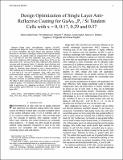| dc.contributor.author | Abdul Hadi, Sabina | |
| dc.contributor.author | Saylan, Sueda | |
| dc.contributor.author | Dahlem, Marcus S. | |
| dc.contributor.author | Nayfeh, Ammar | |
| dc.contributor.author | Milakovich, Timothy J | |
| dc.contributor.author | Bulsara, Mayank T | |
| dc.contributor.author | Fitzgerald, Eugene A | |
| dc.date.accessioned | 2017-05-02T16:24:39Z | |
| dc.date.available | 2017-05-02T16:24:39Z | |
| dc.date.issued | 2015-01 | |
| dc.date.submitted | 2014-09 | |
| dc.identifier.issn | 2156-3381 | |
| dc.identifier.issn | 2156-3403 | |
| dc.identifier.uri | http://hdl.handle.net/1721.1/108586 | |
| dc.description.abstract | Single-layer antireflective coating (SLARC) materials and design for GaAs1_xPx/Si tandem cells were analyzed by TCAD simulation. We have shown that optimum SLARC thickness is a function of bandgap, thickness, and material quality of top GaAs1-xPx/Sisubcell. Cells are analyzed for P fractions x = 0, 0.17, 0.29, and 0.37, and ARC materials: Si3N4, SiO2 , ITO, 11fO2, and Al2O3. Optimum ARC thickness ranges from 65-75 nm for Si3N4 and ITO to ~100-110 nm for SiO2. Optimum ARC thickness increases with increasing GaAs1_xPx absorber layer thickness and with decreasing P fraction x. Simulations show that optimum GaAs1-xPx/Siabsorber layer thickness is not a strong function of ARC material, but it increases from 250 nm for x = 0 to1 μm for x = 0.29 and 0.37. For all P fractions, Si3N4, 11fO2, and Al2O3 performed almost equally, while SiO2 and ITO resulted in ~1% and ~2% lower efficiency, respectively. Optimum SLARC thickness increases as the material quality of the top cell increases. The effect of ARC material decreases with decreasing GaAs1_xPx material quality. The maximum efficiencies are achieved for cells with ~1-μm GaAs0.71P0.29 absorber (r = 10 ns): ~26.57% for 75-nm Si3N4 SLARC and 27.62% for 75-nm SiO2/60-nm Si3N4 double-layer ARC. | en_US |
| dc.description.sponsorship | Masdar Institute of Science and Technology (Abu Dhabi, UAE) | en_US |
| dc.language.iso | en_US | |
| dc.publisher | Institute of Electrical and Electronics Engineers (IEEE) | en_US |
| dc.relation.isversionof | http://dx.doi.org/10.1109/JPHOTOV.2014.2363559 | en_US |
| dc.rights | Creative Commons Attribution-Noncommercial-Share Alike | en_US |
| dc.rights.uri | http://creativecommons.org/licenses/by-nc-sa/4.0/ | en_US |
| dc.source | Fitzgerald | en_US |
| dc.title | Design Optimization of Single-Layer Antireflective Coating for GaAs[subscript 1−x]xP[subscript x]x/Si Tandem Cells With x=0, 0.17, 0.29, and 0.37 | en_US |
| dc.title.alternative | Design Optimization of Single-Layer Antireflective Coating for GaAs1−xxPxx/Si Tandem Cells With x=0, 0.17, 0.29, and 0.37 | en_US |
| dc.type | Article | en_US |
| dc.identifier.citation | Abdul Hadi, Sabina, Tim Milakovich, Mayank T. Bulsara, Sueda Saylan, Marcus S. Dahlem, Eugene A. Fitzgerald, and Ammar Nayfeh. “Design Optimization of Single-Layer Antireflective Coating for GaAs[subscript 1−x]xP[subscript x]x/Si Tandem Cells With x=0, 0.17, 0.29, and 0.37.” IEEE J. Photovoltaics 5, no. 1 (January 2015): 425–431. | en_US |
| dc.contributor.department | MIT Materials Research Laboratory | en_US |
| dc.contributor.department | Massachusetts Institute of Technology. Department of Materials Science and Engineering | en_US |
| dc.contributor.approver | Fitzgerald, Eugene A | en_US |
| dc.contributor.mitauthor | Milakovich, Timothy J | |
| dc.contributor.mitauthor | Bulsara, Mayank T | |
| dc.contributor.mitauthor | Fitzgerald, Eugene A | |
| dc.relation.journal | IEEE Journal of Photovoltaics | en_US |
| dc.eprint.version | Author's final manuscript | en_US |
| dc.type.uri | http://purl.org/eprint/type/JournalArticle | en_US |
| eprint.status | http://purl.org/eprint/status/PeerReviewed | en_US |
| dspace.orderedauthors | Abdul Hadi, Sabina; Milakovich, Tim; Bulsara, Mayank T.; Saylan, Sueda; Dahlem, Marcus S.; Fitzgerald, Eugene A.; Nayfeh, Ammar | en_US |
| dspace.embargo.terms | N | en_US |
| dc.identifier.orcid | https://orcid.org/0000-0002-1891-1959 | |
| mit.license | OPEN_ACCESS_POLICY | en_US |
